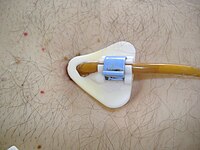
Photo from wikipedia
Resection of large colorectal neoplasia in the rectum can be performed either by endoscopic submucosal dissection (ESD) or by transanal endoscopic microsurgery (TEM). The rate of en bloc resection and… Click to show full abstract
Resection of large colorectal neoplasia in the rectum can be performed either by endoscopic submucosal dissection (ESD) or by transanal endoscopic microsurgery (TEM). The rate of en bloc resection and recurrences were similar in a recent meta-analysis [1] but we are still waiting for the results of the prospective clinical trial performed in France (MUCEM study, NCT02885142) a few years ago. In any case, management of recurrence appears far more complex after TEM than after ESD since the first technique is a fullthickness resection technique although ESD only removes the mucosa and submucosa (▶Fig. 1). Therefore, recurrence at the site of the scar appears similar at the surface, but the deep part of the wall is totally different in the two situations. In the first case, endoscopic resection of the recurrence can be performed by endoscopic submucosal dissection following a deep cut line very close to the muscular layer. In the second, there is no residual muscular layer near the previous resection, and therefore resection should pass under the fibrotic block to avoid damage to the neoplastic tissue and achieve an R0 resection. We present here a case of endoscopic resection of a 5-cm villous recurrence at the site of a previous TEM performed 3 years ago in the MUCEM trial. This lesion invaded the anal verge. An adaptive traction device (A-TRACT 2+2, Hospices Civils de Lyon) was used to improve exposure of the area [2–4] following the current strategy of setup [5]. After circumferential incision, the first two loops were placed at the oral and anal edges of the target area (▶Video 1), and initial dissection and trimming were done using only the auto-traction on these two sides. Once we progressed, traction decreased and we placed the two lateral loops to improve traction on the right and left edges, and the rubber band was fixed to the opposite side to achieve 90° traction. Exposure thanks to the traction allowed us to dissect the area at the different depths that remained under the recurrence with some part in the submucosa, some parts sliding on the longitudinal muscular layer, and finally under the fibrotic block. Resection was R0 without any adverse event and revealed high grade dysplasia. E-Videos
Journal Title: Endoscopy
Year Published: 2023
Link to full text (if available)
Share on Social Media: Sign Up to like & get
recommendations!